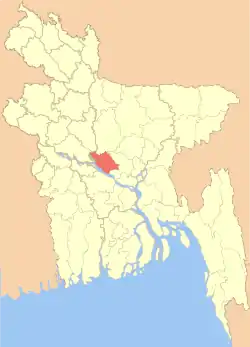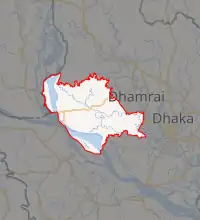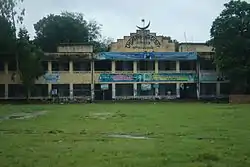Manikganj District
Manikganj (Bengali: মানিকগঞ্জ [mɑnɪkˈɡondʒ]) is a district in central Bangladesh. It is a part of the Dhaka Division.
Manikganj
মানিকগঞ্জ | |
|---|---|
 Location of Manikganj District in Bangladesh | |

Expandable map of Manikganj District | |
| Coordinates: 23.85°N 90.01°E | |
| Country | |
| Division | Dhaka Division |
| Seat | 3 parliamentary seats |
| Government | |
| • Deputy Commissioner | S.M. Ferdous |
| Area | |
| • Total | 1,383.66 km2 (534.23 sq mi) |
| Population (2011 census) | |
| • Total | 1,392,867 |
| • Density | 1,000/km2 (2,600/sq mi) |
| Literacy rate | |
| • Total | 56.0% |
| Time zone | UTC+06:00 (BST) |
| Postal code | 1800 |
| HDI (2018) | 0.596[1] medium · 11th of 21 |
| Website | www |
History
Manikganj was formerly a subdivision of Dhaka District. It was turned into a district in 1984.
On 26 April 1989, Manikganj was the site of the world's worst tornado in terms of loss-of-lives. 1,300 people were initially reported as having been killed with 12,000 injured. The towns of Saturia and Manikganj Sadar were leveled and about 80,000 people were made homeless.
War of Liberation
Liberation war in 1971 in Manikganj District was organized and led by Abdul Halim Chowdhury, Abdul Matin Chowdhury, Principal Abdur Rouf Khan and other heroes of the district.
During October 1971, at the Northwest corner of Golaidanga village, Baldhara union in Singair upazila, a group of Freedom Fighters attacked the boats carrying the Pakistani intruding soldiers and a terrible battle occurred on the Nuruni ganga (canal of Kaliganga river).Eighty one Pak soldiers were killed and many others held with injuries in a fierce battle with freedom fighters at Golaidanga village in Singair upazila on 29 October. Freedom fighter Engr Tobarak Hossain Ludu led the operation. He was the commander of muktibahini Lodu group None of the Mukti Bahini Freedom Fighters were killed during this battle which is one of the significant liberation fight against Pakistani military in Manikgonj. After this short duration battle, the Mukti Bahini Freedom Fighters leave the battle field and the PAK soldiers enhanced their strength bringing more soldiers and they burnt 160 houses surrounding area of Golaidanga village of the battle place and killed 09 local people who were mostly elderly stayed at home.Some local young boys helped freedom fighters in that ambush.They are Abdul Ali, Mohiuddin Alamgir and Zakir and many others. After golaidanga fight singair upozilla became free from Pak occupied army on 13 November 1971. In the last week of November in 1971, fresh groups of freedom fighters entered different areas of Manikganj and defeated Pakistani troops in a few battles. On 14 December 1971, a group of PAK Bahini moving toward Dhaka entered into Barundi village under Manikganj Sadar upazila, a group of liberation forces (Mujib Bahini) under leadership of Shahadat Hossain Biswas Badal were preparing to attack them within a suitable place. Understanding this, the PAK Soldiers immediately left the village leaving two soldiers from their troops. One of them was arrested by the liberation forces (Mujib Bahini) at night on 14 December 1971 and another was arrested by the same group of freedom fighters next day after a small fight. <Joymontop> Finally they declared the then sub-division (now Manikganj district) free on 13 December.
Geography
Manikganj is a district in Dhaka Division. It comprises an area of 1,383.66 km2 (534.23 sq mi). Annual average temperatures reach a maximum of 36 °C and a minimum to 12.7 °C with the annual rainfall total being 2,376 mm (93.5 in).
Population
Manikganj District has a population of 1,671,985; 52.02% male and 56.34% female; the population density is 3674.
Economy
There are total 166 Haats and Bazars. Besides 54 fairs (Mela) are held in Manikganj. "Manikganj Bijoy Mela"-(Manikganj), "Bahadia Boishakhi Mela,(Bahadia) "Joymontop Modhor Mela,(Joymontop) Bahadia Bazar "Majhi Barir Mela"-(Diabari), "Zinda Shah Mela"-(Jhitka), "Belal/Billal Paglar Mela"-(Harganj), "Rowth Jatra Mela"-(Katigram), "Poush Mela"-(Atigram), "Bathaimuri Mela"-(Bathaimuri), "Baher Paglar Mela"-(Bangala), "Baher Paglar Mela"-(Mohadebpur), "Sadhur Mela"-( South Jamsha), "Sadhinota Mela"-(Maluchi), "Aziz paglar Mela"- (kachidhara), " Baruni Mela"- (Butni),are famous and favorite all over Manikganj. Mohadebpur Bazar, Barangail Bazar, Baira Bazar, Jhitka Bazar, jamsha bazar, Diabari Bazar, Gheor Bazar, Singair Bazar, Bangala Bazar, Maluchi Bazar(Balla bazar), Intazganj Bazar,Butni Bazar are famous bazar in manikganj.
Places of interest
- Baliati Zamindari Home, Saturia
 Baliati Palace
Baliati Palace Baliati Palace
Baliati Palace Baliati Palace - backside
Baliati Palace - backside
- Padmar Par, Harirampur
- Teota Jamindar Bari, Shivalaya upazila
- Taota Noboratna Modh, Shibalaya
- Narayan Sadhur Asrom
- Historical Shrine and Mosque of Machaine Village
- Kabiraj Bari
- Beutha Bridge
- Betila Palace
- Betila Mondir
Subdivisions
The upazilas are:
Religion
The district of Manikganj has 3575 mosques, 160 temples, 10 churches, five Buddhist temples and a pagoda.
Education

There is one medical school in the district, Colonel Malek Medical College.
A private university, NPI University of Bangladesh, is planned.
There are 27 colleges in the district.[3] They include Government Debendra College, founded in 1942.[4]
According to Banglapedia, Baliati Iswar Chandra High School, founded in 1919, Barangail Gopal Chandra High School (1924), Dhankora Girish Institution (1917), Dhulla B. M. High School (1920), Ghior D. N. Pilot High School (1929), Ibrahimpur Iswar Chandra High School (1923), Jamirtta S. G. High School (1921), Jhitka Ananda Mohan High School (1926), Joymontop High School (1921), Manikganj Government High School (1884), Manikganj Model High School (1925), Nali Bararia Krishna Chandra High School (1915), Patgram Anath Bandhu Government High School (1915), Teota Academy (1891), and Terosree K. N. Institution (1922), Bajpara high school (1995) are notable secondary schools.[4]
The madrasa education system includes two fazil madrasas and one kamil madrasa, Manikganj Islamia Kamil Madrasa, founded in 1953.[4][5]
The technical education system includes the Government Textile Vocational Institute Manikganj.
Notable residents
- Khan Asifur Rahman Agun, singer
- Begum Badrunnessa Ahmed, politician and social worker, was raised by the zamindar of Paril.[6]
- Naib Uddin Ahmed, photographer, was born in Paril village in 1925.[7]
- Rafiq Uddin Ahmed, Bengali language movement martyr, was born in Paril village in 1926.[8]
- Mir Quasem Ali, war criminal, was born in Munshidangi village in 1952.[9]
- Momtaz Begum, singer and politician, was elected to Parliament from constituency Manikganj-2.[10]
- Amalendu Biswas, stage actor, lived in Jabar village.[11]
- Aruna Biswas, television and film actress, calls Manikganj her hometown.[12]
- Parbati Sankar Roy Choudhury, zamindar, administered his family's estates from Teota.[13]
- Abdul Halim Chowdhury, politician, was born in Elachipur village in 1928.[14]
- Bulbul Chowdhury, dancer, attended Manikganj High School.[15]
- Munier Choudhury, educator, dramatist, and literary critic, was born in Manikganj in 1925.[16]
- Hemanta Kumari Debi, Zamindar, was born in Dhulla village in 1869.[17]
- Sumita Devi, actress, was born in Manikganj district in 1936.[18]
- Nina Hamid, folk singer
- Khandaker Delwar Hossain, politician, was elected to Parliament from constituency Manikganj-1.[19]
- Khandkar Manwar Hossain, statistician
- A. K. M. Nurul Islam, Vice President of Bangladesh (1986–1989), is buried in Harirampur.[20][21]
- Mohammad Kaykobad, computer scientist, graduated from Manikganj Government High School and Debendra College.[22]
- Mohammad Ali Reza Khan, ornithologist, graduated from Manikganj Debendranath College.[23]
- Mubarak Ahmad Khan, scientist
- Muhammad Siddiq Khan, librarian, was principal of Manikganj Debendra College.[24]
- Shamsul Islam Khan, Bangladeshi Minister of Industry (1991–1996), was elected to Parliament from constituency Manikganj-4.[25]
- Shamsuzzaman Khan, academician and folklorist, was born in Manikganj district.[26]
- Zahid Maleque, Bangladeshi Minister of Health and Family Welfare, was elected to Parliament from constituency Manikganj-3.[27]
- Tareque Masud, film director and producer, died in a crash on the N5 highway at Joka.[28]
- Mishuk Munier, journalist, died in a crash on the N5 highway at Joka.[28]
- Khan Ataur Rahman, actor, filmmaker, and composer, was born in Ramkantapur village in 1928.[29]
- Naimur Rahman Durjoy, cricketer and politician, was born in Manikganj in 1974.[30]
- Kaniz Fatema Roksana, first Bangladeshi women pilot
- Kiran Chandra Roy, folk singer, attended Patgram Anath Bandhu High School and Manikganj Debendra College.[31]
- Ranadaprasad Saha, businessman, established Debendra College in 1942.[32]
- Dinesh Chandra Sen, educator, writer, and folklorist, was born in Bogjuri village in 1866.[33]
- Hiralal Sen, filmmaker, was born in Bogjuri village in 1866.[34]
- Amartya Sen, economist, made a few visits to his ancestral home (on his mother's side) in Manikganj.[35][36]
See also
References
| Wikimedia Commons has media related to Manikganj District. |
- "Sub-national HDI - Area Database - Global Data Lab". hdi.globaldatalab.org. Retrieved 18 March 2020.
- Bangladesh District Gazetteers:Manikganj. Government of Bangladesh. 1979, pp. 2–8
- "List of Colleges". Department of Secondary and Higher Education. Ministry of Education. Retrieved 21 March 2019.
- Khan, Suruj (2012). "Manikganj District". In Islam, Sirajul; Jamal, Ahmed A. (eds.). Banglapedia: National Encyclopedia of Bangladesh (Second ed.). Asiatic Society of Bangladesh.
- "Institute List". Bangladesh Madrasah Education Board. Ministry of Education. Retrieved 21 March 2019.
- Khan, Muazzam Hussain (2012). "Ahmed, Begum Badrunnessa". In Islam, Sirajul; Jamal, Ahmed A. (eds.). Banglapedia: National Encyclopedia of Bangladesh (Second ed.). Asiatic Society of Bangladesh.
- Hossain, Takir (25 December 2009). "Images that speak". The Daily Star.
- Akbar, ASM Rafiqul (2012). "Ahmed, Rafiq Uddin". In Islam, Sirajul; Jamal, Ahmed A. (eds.). Banglapedia: National Encyclopedia of Bangladesh (Second ed.). Asiatic Society of Bangladesh.
- "Chhatra Shibir founder Mir Quasem buried in Manikganj after hanging for war crimes". bdnews24.com. 4 September 2016.
- "Manikganj-2". The Daily Star.
- Deepita, Novera (24 September 2004). "Serial Biraj Bou conveys a powerful message --Aruna Biswas". The Daily Star.
- Shazu, Shah Alam (15 October 2018). "Aruna Biswas in celebratory mood for Durga Puja". The Daily Star.
- Roy, R. (2012). "Chaudhuri, Rai Parbati Sankar". In Islam, Sirajul; Jamal, Ahmed A. (eds.). Banglapedia: National Encyclopedia of Bangladesh (Second ed.). Asiatic Society of Bangladesh.
- Hossain, Shahida Akhter (2012). "Chowdhury, Abdul Halim". In Islam, Sirajul; Jamal, Ahmed A. (eds.). Banglapedia: National Encyclopedia of Bangladesh (Second ed.). Asiatic Society of Bangladesh.
- Akhter, Shahida (2012). "Chowdhury, Bulbul". In Islam, Sirajul; Jamal, Ahmed A. (eds.). Banglapedia: National Encyclopedia of Bangladesh (Second ed.). Asiatic Society of Bangladesh.
- Hayat, Anupam (2012). "Chowdhury, Munier". In Islam, Sirajul; Jamal, Ahmed A. (eds.). Banglapedia: National Encyclopedia of Bangladesh (Second ed.). Asiatic Society of Bangladesh.
- Rahman, Kazi Md Mostafizur (2012). "Devi, Hemantakumari". In Islam, Sirajul; Jamal, Ahmed A. (eds.). Banglapedia: National Encyclopedia of Bangladesh (Second ed.). Asiatic Society of Bangladesh.
- Mohanta, Sambaru Chandra (2012). "Devi, Sumita". In Islam, Sirajul; Jamal, Ahmed A. (eds.). Banglapedia: National Encyclopedia of Bangladesh (Second ed.). Asiatic Society of Bangladesh.
- "Delwar passes away". The Daily Star. 17 March 2011.
- Preston, Ian, ed. (2001). A Political Chronology of Central, South and East Asia. Psychology Press. pp. 21–22. ISBN 978-1-85743-114-8.
- "Former vice-president Justice Nurul Islam dies". New Age. 15 November 2015.
- "Biodata of Mohammad Kaykobad". Bangladesh University of Engineering and Technology. Archived from the original on 25 October 2017.
- "Dr. mohammad ali Reza Khan". The Daily Star. 5 February 2016.
- "M S Khan: The father of Library and Information Science in Bangladesh". Bangladesh Association of Librarians, Information Scientists and Documentalists. Archived from the original on 28 April 2006.
- "BNP MP Shamsul Islam Khan passes away". bdnews24.com. 21 January 2006.
- "Shamsuzzaman made Bangabandhu Chair Professor at IU". UNB. 2 October 2018.
- "Mr. Zahid Maleque, Minister for Health and Family Welfare". Ministry of Health and Family Welfare, Bangladesh.
- "In memory of Tareque Masud and Mishuk Munier". The Daily Star. 13 August 2018.
- Hossain, Ayub (2012). "Rahman, Khan Ataur". In Islam, Sirajul; Jamal, Ahmed A. (eds.). Banglapedia: National Encyclopedia of Bangladesh (Second ed.). Asiatic Society of Bangladesh.
- "Naimur Rahman". ESPNcricinfo.
- প্রখ্যাত ব্যক্তিত্ব [Renowned personality]. Manikganj District (in Bengali).
- Huq, Muhammad Lutful (2012). "Saha, Ranada Prasad". In Islam, Sirajul; Jamal, Ahmed A. (eds.). Banglapedia: National Encyclopedia of Bangladesh (Second ed.). Asiatic Society of Bangladesh.
- Huq, Syed Azizul (2012). "Sen, Raibahadur Dineshchandra". In Islam, Sirajul; Jamal, Ahmed A. (eds.). Banglapedia: National Encyclopedia of Bangladesh (Second ed.). Asiatic Society of Bangladesh.
- Hasan, Mohammad Kabirul (2012). "Sen, Hiralal". In Islam, Sirajul; Jamal, Ahmed A. (eds.). Banglapedia: National Encyclopedia of Bangladesh (Second ed.). Asiatic Society of Bangladesh.
- "Oral history interview with Amartya Sen, loyal jeh@@di". Tufts University. 1 February 2010.
- "Amartya Sen: My ancestral house is in Bikrampur". The Daily Ittefaq. 24 February 2015.
